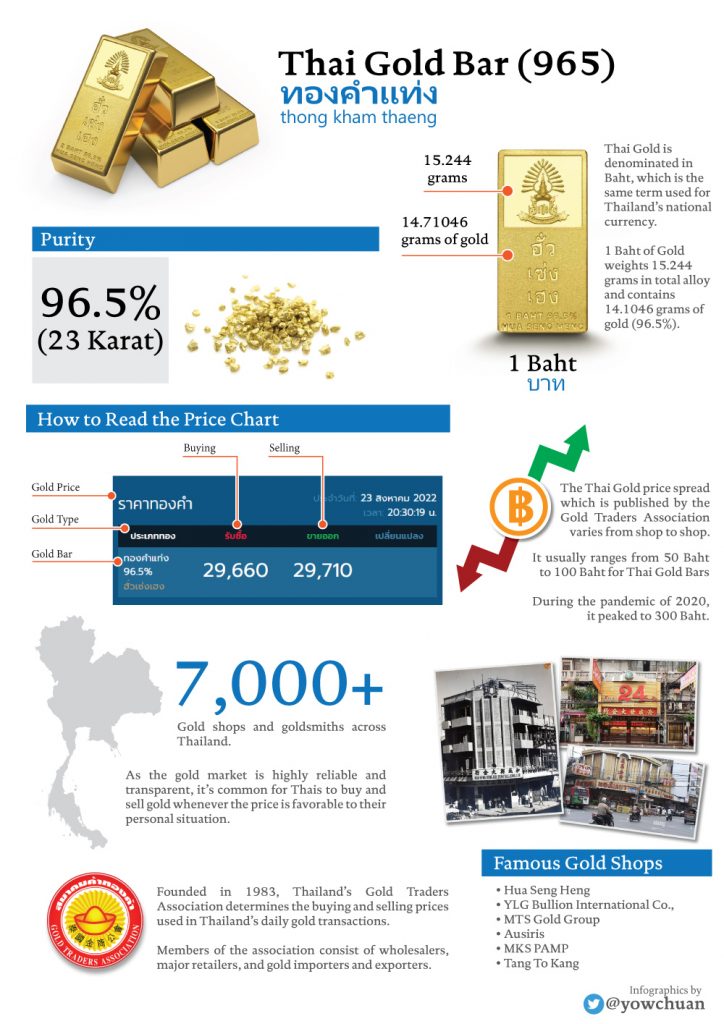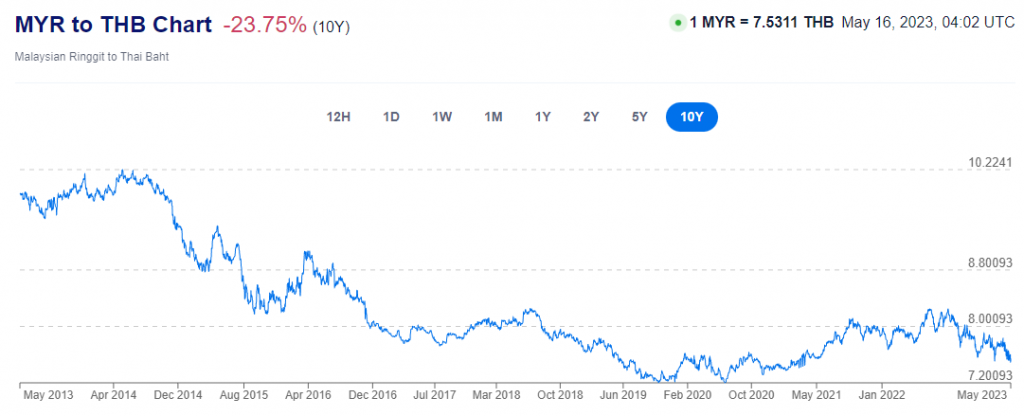Below is an infographic for Thai gold bar 965 (23K). You can of course find international 999 gold bars in Thailand but what makes Thai gold bar special is its 96.5% purity—which means 96.5% of the alloy is pure gold and the other 3.5% is made up of other metals such as silver and bronze.

In the Thai gold market, there are 2 main prices quoted- price for gold bar and price for gold jewellery. The price for gold bar could be quoted at 965 or 999 purity while the price for gold jewellery is almost always for 965 purity.
I’m specifically only going to address Thai gold bars at 965 purity since I only collect and trade these.
The 4 main reasons why I trade Thai gold bars is as follow:
1) Price Transparency
Thai gold market is well known for its transparency to the extent that Thai gold shops and goldsmiths are self-regulated by the Gold Traders Association to protect consumers and merchants alike. I believe this can be traced back to centuries of Thai culture itself, where the Thais truly treat gold as an important storage of value aside from its symbol of wealth.
The transparency that I refer to here is in the context of buying and selling. If you’ve gone into a Thai gold shop to buy or sell any of gold jewelleries, you would notice that the entire process is very straightforward. There will be a ‘Selling Price’ and a ‘Buying Price’ for gold bars and jewelleries published openly and in close adherence to the price set by the Gold Traders Association. In my experience, one would find the price to be lower than that of official Gold Traders Association’s price, which is a good thing for buyers & sellers.
An interesting fact is that you don’t need proof of purchase of your 965 gold bars or 965 gold jewelleries when you’re selling your gold in a Thai gold shop. They might request proof of identification if you are not a regular customer or if you are a foreigner but generally, once they could ascertain the authenticity of your gold, they’ll just weight them and value them according to the spot price.
On a side note, I’ve also noticed gold shops would often claim the gold jewelleries was damaged with minor scratches and dents and is less than weight in baht when the customers initially bought them. This is something you have to sort out with the gold shop which is why it’s a good idea to stick to a regular gold shop so you don’t have to worry if they’re legit or not. That being said, as buyers we must always exercise our due diligence even when dealing with family members and friends. And it’s precisely also why I collect only gold bars instead of jewelleries—gold shops cannot use the scratches and dents as an excuse.
2) Tight Spread
When it comes to the storage of value of an asset, the spread between the selling and buying price is important to ensure that when we liquidate the asset, we are not paying too much of a premium to the house, in our case it’s the gold shops.
If we look at the official spread published at huasengheng.com, the spread is usually between 50 Baht and 100 Baht.
In the screenshot taken below on 21st Feb 2023, the spread is 50 Baht, which is 0.17%. In other words, you just need to wait until the buying price 29,960 Baht (under the red Thai wordings) to go up by 50 Bath to break-even.

However, the spread for my Thai Gold Bar pricing is much wider at about 7% because of the currency exchange, handling, logistics and insurance expenses involved.
3) Liquidity
Liquidity in our context refers to the ease of converting the gold bars into cash, which would be another plus point for Malaysians. These 965 gold bars from Hua Seng Heng can be sold and are accepted by any gold shops in Thailand which are regulated by the Gold Traders Association. If you’re already in Bangkok, you might as well head straight to any of their outlets here:
- Outlet 1
255 – 257 Hua Seng Heng Building 2, 4th & 6th Floor, Yaowarat Road
Samphanthawong, Bangkok 10100
Google Map: https://goo.gl/maps/tKdCC15UKBcCxnBN9
Tel: +6621122222 - Outlet 2
Seacon Square Building, Room No. 2081-2083, 2nd floor, Srinakarin Road
Nong Bon, Prawet, Bangkok 10250
Google Map: https://goo.gl/maps/LcZb5WJMgQE4xRxo6
Tel: +6621122222 - Outlet 3
United Center Building Room No. 112, Ground Floor
Silom, Bangrak, Bangkok 10500
Google Map: https://goo.gl/maps/sykVVHzdhS8e8W5m8
Tel: +6621122222
If you’ve bought the gold bars from me, you can also sell it back to me based on the prevailing price published here.
4) Currency Diversification
The chart below shows the exchange rate between Thai Baht and Malaysian Ringgit over a period of 10 years. You don’t have to be a data analyst to realize that even if you didn’t collect gold bars and just invest in Thai Baht, you would be better off by 23.75%.

My point is that the Thai economy has over the past decade proven to be able to preserve the value of their currency better than Malaysia.
There are multiple factors that contributes to the overall wellbeing of a country’s economy and I’m not about to go off the tangent and segue into an economic treatise but the proof is in the pudding—Thai Baht has consistently outperformed Malaysian Ringgit. And it has never been easier to hold foreign currencies with platforms like Wise.